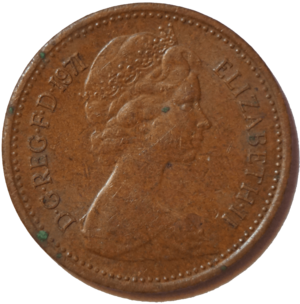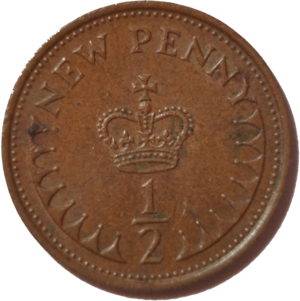Halfpenny (British decimal coin) facts for kids
| United Kingdom | |
| Value | £0.005 |
|---|---|
| Mass | 1.78 g |
| Diameter | 17.14 mm |
| Thickness | 1 mm |
| Edge | plain |
| Composition | bronze |
| Years of minting | 1971–1984 |
| Obverse | |
 |
|
| Design | Queen Elizabeth II |
| Designer | Arnold Machin |
| Design date | 1971 |
| Reverse | |
 |
|
| Design | St Edward's Crown |
| Designer | Christopher Ironside |
| Design date | 1971 |
The British decimal halfpenny (1⁄2p) coin was a small coin used in the UK. It was introduced in February 1971. This was when Britain changed to a new money system called decimalisation. The halfpenny was worth half of one penny. This means it was 1⁄200 of one pound.
Banks usually ignored this coin in their transactions. They preferred to deal with whole pence. The halfpenny was created to help set prices more accurately. It allowed shops to price items with a half-penny value. This also helped keep the old sixpence coin in use for a while.
The halfpenny coin showed Queen Elizabeth II on one side. The other side featured St Edward's Crown. It was made of bronze, just like the 1p and 2p coins. It was the smallest coin in Britain at the time. Many people did not like using it. The government believed it helped stop prices from going up too much. However, the coin was officially removed from circulation in December 1984.
Contents
Coin Design and Features
Let's explore what the halfpenny coin looked like.
The Back of the Coin (Reverse)
The back of the coin was designed by Christopher Ironside. It showed a picture of St Edward's Crown. Below the crown, you could see the number "12". This clearly showed its value.
From 1971 to 1981, the words NEW PENNY were above the crown. From 1982 to 1984, this changed to HALF PENNY.
The Front of the Coin (Obverse)
Only one design was used for the front of the halfpenny coin. This side showed a portrait of Queen Elizabeth II. The artist who created this portrait was Arnold Machin. In this picture, the Queen wears a special crown called the 'Girls of Great Britain and Ireland' Tiara.
Around the Queen's portrait, you could read ELIZABETH II D.G.REG.F.D.. The year the coin was made, like 1971 or 1984, was also there. Both sides of the coin had tiny dots around the edge. This common coin feature is called beading.
How Many Halfpenny Coins Were Made?
Many halfpenny coins were produced over the years. Here's a look at how many were minted for general use.
| Year | Number minted |
|---|---|
| 1971 | 1,394,188,251 |
| 1972 | Only in special collector sets |
| 1973 | 365,680,000 |
| 1974 | 365,448,000 |
| 1975 | 197,600,000 |
| 1976 | 412,172,000 |
| 1977 | 66,368,000 |
| 1978 | 59,532,000 |
| 1979 | 219,132,000 |
| 1980 | 202,788,000 |
| 1981 | 46,748,000 |
| 1982 | 190,752,000 |
| 1983 | 7,600,000 |
| 1984 | Only in special collector sets |
Even if a year shows 'none' for circulation, some coins might exist. These would be found in special collector sets made since 1982.
A Coin That Was Never Made
There was a plan for an even smaller coin. This was a decimal quarter-penny coin. It would have been made of aluminium. This coin would have allowed the old threepence coin to stay in use. The threepence would have been worth 1+1⁄4 new pence. However, this quarter-penny coin was never actually produced.
See also
- Halfpenny (Irish decimal coin)

